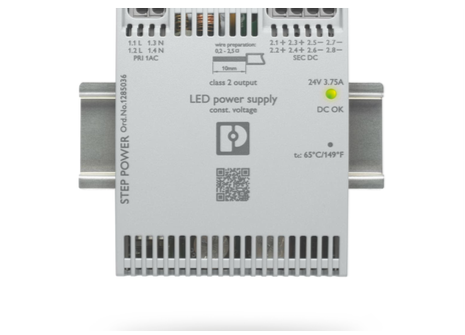Bringing light into the darkness – reliable supply of LED applications

Andreas Bitsilia, Product Marketing, Nadine Schneider, Marketing Communications, Phoenix Contact Power Supplies Paderborn, Germany
LED lighting has become indispensable in our everyday world. Professional solutions in new buildings or renovations provide more options for customers to light rooms just the way they want. But what does a reliable and safe supply look like? Phoenix Contact has developed a new solution that fits the bill.
(Lead image)
The new 24 V LED power supply in the Step Power product family combines a very flat design with very high power density. It is suitable for installation in the distribution board and in suspended ceilings, as it can be mounted on a DIN rail as well as a flat surface.
Different options achieve the desired result
In order to operate, every LED requires a defined current and a defined voltage. Even a classic LED bulb, which has replaced the erstwhile incandescent bulb in all kinds of sockets, has an integrated transformer to ensure that the LED is reliably supplied with power. This type of installation is always a good option when the bulb fittings can be mounted very easily anywhere where 230 V is already wired, but mostly in the case of a classic retrofit. If a higher level of functionality is desired, the customer usually purchases an LED bulb that they can control wirelessly, for example. Optimum connection via WLAN or Bluetooth and even solutions such as the popular Zigbee standard play a major role here. In fact, with these solutions it is very easy to achieve certain smart home capabilities, such as dimming the light, mixing colors, and thus creating ambient lighting. Unfortunately, the safety and security of these comparably cheaper devices is not always guaranteed. That is because it is not just the quality of the network connection that can influence function. Time and again there are cases where networks are actually compromised by these devices and as a result access is gained to other components in the home.
It is a different matter when construction companies design a building from scratch, whether it is a new building or a full renovation or redevelopment. Here, considerably more functions can be implemented by other means and indeed more safely and securely. Supplying the LED lighting with a 24 V SELV voltage plays a significant role in this case. There are two suitable options as standard.
With the first option, the supply of the lights is decentralized, i.e., they are supplied with SELV voltage by a power supply unit near the lighting, and the lights are controlled by means of a wired or wireless connection, for example. This enables smart lighting concepts to be implemented and tailored to individual customer requirements. However, there must be sufficient space available for the power supply unit. This is often located in a suspended ceiling, for example, which means that additional construction costs and the living space that is used must be taken into account.
Here is a realistic example using an apartment with an area of approximately 100 m². To provide sufficient illumination, approximately 250 - 300 lumens are recommended per square meter. With modern LED lights, this corresponds to approximately 30,000 lumens and therefore 300 watts. In terms of the individual lights, we can assume approximately 15 individual circuits and therefore 15 individual power supplies. There is significant wiring effort involved in the installation of these power supply units. During operation, the individual devices also result in high losses overall, as smaller devices cannot achieve the efficiency gains of larger devices. The power supply units also always have a statistical failure time (MTBF). With multiple devices, the number of failures also multiplies. In this case, it would again take a great deal of effort to install a replacement device. You first need to locate the devices in the suspended ceiling before you can even start the laborious process of replacing them.

With the second option, the LED lights are supplied centrally, i.e., directly from the control cabinet of the main distribution or subdistribution. The clear advantage of this solution is that the lighting is also controlled centrally. The typical standards here are KNX, DALI, and LOXONE, which offer a wide range of options in their portfolio. There is sufficient space to accommodate the power supply units in the distributor box – they are no longer distributed throughout the building.
Based on the earlier example, with a centralized design, just a few devices with the appropriate power rating would be enough to reliably supply the entire lighting for the apartment. The devices are wired in a fraction of the time and, if maintenance is required, the faulty device is quickly identified and can be replaced just as quickly. The significantly higher efficiency of these power supply units also makes them environmentally-friendly and cost-effective.
Reality meets the specifications of standards
The centralized use of power supply units is becoming more and more established in practice. Unfortunately, the choice of devices is limited. Either the devices meet the requirements of the LED standard ((which standard is it and what does it require? => I hope the information below is sufficient)) and do not have a DIN rail connection, or the devices are industrial devices that do not meet the requirements of the LED standard. In reality, this often causes problems. Attaching LED power supply units without a DIN rail connection in the control cabinet requires extra effort. If industrial power supply units are installed, their use violates the standard. For use as an LED power supply unit, the device must be tested and approved in accordance with safety standard EN 61347-2-13 as well as EMC standards EN 55015 and EN 61547 ((by the manufacturer? => the tests and declaration may be carried out independently at your own risk. In the case of Phoenix Contact power supplies, the tests are always performed by accredited laboratories)). One cannot assume that industrial power supply units meet the requirements of the LED standard per se. It is also important to keep in mind that industrial devices are relatively robust in withstanding ambient conditions, but are not free of interference. In addition to the normal tests, EMC standard 55015 also requires the testing of 9 kHz to 30 MHz frequencies. These measurements are not performed for industrial power supply units, so if interference is emitted on these frequencies, it can have an adverse effect on other devices, causing lights to flicker, for example.
The perception of light, and its associated flickering, has been researched extensively. The findings of these studies show just how much the human body can benefit from light, but also how disruptive it can be. Even though perception is very subjective, a customer’s quality of life should never be impaired simply because the wrong power supply unit was chosen.
Now in its third generation, the Step Power series was recently extended to include a power supply unit specifically designed for LED lighting. The STEP3-PS/1AC/24DC/3.75/PT/LED device has a constant output voltage of 24 V and can supply a current of 3.75 A. It is therefore ideally suited to the task of supplying three separate LED circuits of 30 W, for example. The device offers the same familiar features of the Step Power series. So, with an overall width of 72 mm, the device is extremely compact. It achieves an unprecedented efficiency level of 92.5 to 94 percent. When LEDs are switched off, which is usually the case during the day, the power supply unit enters a very efficient standby mode, resulting in just very small losses below 0.21 watts. This high level of efficiency ultimately saves money each year and protects the environment.
Furthermore, the power supply features a very flat design combined with very high power density. The device can be used on the DIN rail and is also suitable for direct mounting on a flat surface. The devices are therefore ideal for installation in a distribution board or in suspended ceilings. Thanks to the Push-in connection technology, wiring is quick and straightforward.
Last but not least, the power supply unit meets the requirements of the aforementioned safety and EMC standards for use as an LED power supply unit. As prescribed by the standard, a temperature point (TC point) is indicated on the front. This means that the power supply unit can be monitored using a temperature sensor and the specified operation is ensured.
Summary
The professional supply of LED lights is no trivial matter and can be ensured by the new Step Power LED power supply unit solution. With its extremely high efficiency and low no-load losses, the approved and standard-compliant device offers many advantages. It represents an attractive complete package that makes it possible to satisfy the individual lighting needs of customers.
More information
http://www.phoenixcontact.com/steppower
STEP POWER power supply for LED applications | PHOENIX CONTACT
Related Posts


